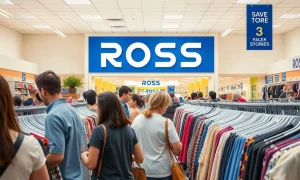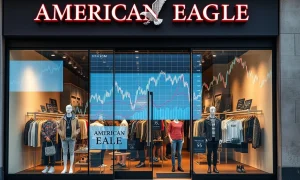The retail sector faces continuous challenges. A prominent women’s fashion chain, Chic Threads, recently announced a devastating decision. The company will close all its physical stores. This action comes as part of a Chapter 11 bankruptcy filing. This move signals a significant moment for the industry. It underscores the ongoing shifts impacting traditional retail models. Consequently, the news sends shockwaves through the fashion world. Many observers now ponder the broader implications of this **women’s fashion bankruptcy**.
The Unraveling of a Retail Giant
Chic Threads has been a staple in women’s fashion for decades. It offered a wide range of apparel and accessories. However, the company struggled with evolving market conditions. Increasing competition from online retailers played a significant role. Furthermore, changing consumer preferences presented new hurdles. These factors combined to create immense financial pressure. Ultimately, the company sought protection under Chapter 11. This decision allows for a structured reorganization process. It also facilitates the closure of all its physical retail locations.
The announcement impacts hundreds of stores nationwide. Thousands of employees will lose their jobs. This outcome highlights the harsh realities facing many brick-and-mortar businesses today. Consumers will also feel the effects. They will no longer have access to their favorite styles from Chic Threads. This closure represents a major loss in the retail landscape. Therefore, understanding the context of this **women’s fashion bankruptcy** is crucial.
- Widespread Store Closures: All Chic Threads physical locations will cease operations.
- Job Losses: Thousands of retail employees face unemployment.
- Consumer Impact: Shoppers lose a familiar fashion destination.
- Industry Shift: This event reflects a broader trend in retail.
Understanding Chapter 11 Bankruptcy
Chapter 11 bankruptcy provides a legal framework. It allows businesses to reorganize their finances. Companies typically aim to stay operational. They work to repay creditors over time. This differs from Chapter 7 bankruptcy. Chapter 7 usually involves liquidation of assets. For Chic Threads, Chapter 11 offers a path. It helps them manage debts and wind down operations systematically. This process often involves selling off inventory. It also includes liquidating other assets. Ultimately, it aims to maximize recovery for creditors.
The court oversees this entire process. A trustee may be appointed. They ensure fair treatment for all parties involved. This includes employees, suppliers, and landlords. For Chic Threads, the Chapter 11 filing means a controlled exit. It avoids a chaotic shutdown. Consequently, it allows for a more orderly unwinding of the business. This strategic move aims to mitigate further financial damage. It is a complex legal procedure. It is frequently used by large corporations facing severe financial distress. This legal framework defines the terms of the **women’s fashion bankruptcy**.
The Ripple Effect of Women’s Fashion Bankruptcy
The closure of a major chain like Chic Threads creates a ripple effect. Firstly, it impacts the commercial real estate market. Empty storefronts appear in malls and shopping centers. This can lead to decreased foot traffic for neighboring businesses. Secondly, suppliers and vendors face significant losses. They may have outstanding invoices. These businesses often rely on large retailers for substantial revenue. Their financial stability can be threatened. Therefore, the impact extends far beyond the direct employees and customers of the bankrupt chain.
Furthermore, the broader fashion industry feels the pressure. Other retailers might see increased competition. They could also face a more cautious lending environment. This **women’s fashion bankruptcy** highlights several underlying issues. These include shifting consumer spending habits. There is also the rise of direct-to-consumer brands. Supply chain disruptions have also played a role. Inflationary pressures contribute to higher operating costs. Consequently, many fashion businesses find themselves at a crossroads. They must adapt or face similar fates.
The situation also affects the labor market. Experienced retail workers become available. They seek new employment opportunities. This can increase competition for existing jobs. Moreover, the closure impacts the overall perception of the retail sector. It signals vulnerability. Businesses must innovate to survive. This case serves as a stark reminder of retail’s evolving nature.
Navigating the Future of Retail Amidst Women’s Fashion Bankruptcy
The retail landscape is constantly evolving. The recent **women’s fashion bankruptcy** of Chic Threads underscores this fact. Digital transformation continues at a rapid pace. E-commerce platforms now dominate consumer spending. Many shoppers prefer the convenience of online purchasing. They also enjoy wider selections. Brick-and-mortar stores must offer unique experiences. They need to provide compelling reasons for customers to visit. Otherwise, they risk becoming obsolete.
Successful retailers are adapting. They invest in omnichannel strategies. This means integrating online and offline shopping experiences. They use technology to enhance customer engagement. Personalized recommendations are common. In-store pickup options are popular. Virtual try-ons are also gaining traction. Furthermore, sustainable practices are becoming more important. Consumers increasingly demand ethical sourcing and eco-friendly products. Companies ignoring these trends face significant challenges. The future of retail demands agility and innovation. This is especially true in the competitive women’s fashion segment.
Retailers are exploring new business models. Subscription services are one example. Pop-up shops offer flexibility. Experiential retail creates immersive brand interactions. These strategies help businesses connect with modern consumers. They also build brand loyalty. Therefore, the current challenges, including significant **women’s fashion bankruptcy** events, force a necessary reevaluation of traditional retail approaches.
Protecting Consumers and Employees
When a company files for Chapter 11, concerns arise. Employees worry about their jobs and benefits. Consumers wonder about gift cards and returns. The bankruptcy court addresses these issues. Employee wages and benefits are often prioritized. However, severance packages may be limited. Some employees might receive preference over general creditors. This depends on the specific circumstances of the filing. Support programs are sometimes available. These help displaced workers find new employment.
For consumers, the situation is more complex. Gift cards may become worthless. This often happens if the company liquidates entirely. However, in Chapter 11, there might be a grace period. Customers could use gift cards for a limited time. Returns and exchanges might also be restricted. Therefore, consumers are often advised to act quickly. They should use gift cards or make returns promptly. This protects their interests during the bankruptcy process. This ensures they do not lose out due to the **women’s fashion bankruptcy**.
Creditors, including suppliers and landlords, typically file claims. They hope to recover a portion of their debts. The bankruptcy court determines the order of repayment. Secured creditors usually receive priority. Unsecured creditors may receive less, or nothing at all. This highlights the financial risks involved in doing business with struggling companies. The legal framework aims for fairness. However, not all parties recover their full losses.
The closure of Chic Threads serves as a stark reminder. The retail sector remains dynamic and challenging. Companies must adapt to changing consumer behaviors. They need to embrace digital transformation. Those that fail to innovate risk significant financial distress. Ultimately, this **women’s fashion bankruptcy** is a powerful case study. It illustrates the pressures faced by traditional retail in the modern economy.

Frequently Asked Questions (FAQs)
1. What does Chapter 11 bankruptcy mean for a business?
Chapter 11 bankruptcy allows a company to reorganize its finances. It helps the business repay debts while remaining operational. This process differs from liquidation. The goal is to emerge as a healthier entity. However, it can also lead to controlled closures, as seen with this **women’s fashion bankruptcy**.
2. Why did Chic Threads close all its stores?
Chic Threads closed all stores as part of its Chapter 11 filing. The company faced immense financial pressure. This stemmed from intense online competition and shifting consumer habits. High operating costs also played a role. Store closures are often a necessary step in retail bankruptcy reorganization.
3. What happens to gift cards when a store files for bankruptcy?
The fate of gift cards varies. In Chapter 11, companies might honor them for a limited period. This depends on court approval. However, if the company liquidates, gift cards often become worthless. Consumers should use them quickly after a bankruptcy announcement.
4. How does this bankruptcy affect employees?
Employees often face job losses. They may receive limited severance. Wages and benefits are usually prioritized in bankruptcy proceedings. However, securing new employment can be challenging. This **women’s fashion bankruptcy** impacts many livelihoods.
5. Is this a common trend in the retail industry?
Yes, retail bankruptcies have become more common. Traditional brick-and-mortar stores face increasing pressure. The rise of e-commerce, changing consumer preferences, and economic factors contribute to this trend. Many retailers are forced to adapt or close.
6. What are the broader implications for the fashion industry?
This bankruptcy highlights the need for innovation. Fashion retailers must embrace omnichannel strategies. They need to focus on unique customer experiences. Sustainability and digital engagement are also key. The industry must evolve to survive these ongoing challenges.






















